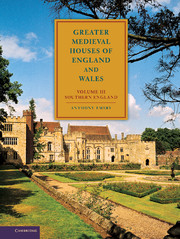Book contents
- Frontmatter
- Contents
- Acknowledgements
- List of abbreviations
- Introduction
- PART I THE THAMES VALLEY
- PART II LONDON AND SOUTH-EAST ENGLAND
- 6 London: an introduction
- 7 London: bibliography
- 8 London: survey
- 9 South-east England: historical background
- 10 South-east England: architectural introduction
- 11 The impact of the Hundred Years' War on English domestic architecture
- 12 South-east England: bibliography
- 13 South-east England: survey
- Appendix 3 London and south-east England castles: residential additions
- Appendix 4 London and and south-east England: residential licences to crenellate
- PART III SOUTH-WEST ENGLAND
- Appendix 5 Castles of south-west England: residential additions
- Appendix 6 South-west England: residential licences to crenellate
- Appendix 7 The architectural value of John Leland and the Buck brothers
- List of plates
- List of figures
- Index
- Index of houses in volumes I, II and III
9 - South-east England: historical background
from PART II - LONDON AND SOUTH-EAST ENGLAND
Published online by Cambridge University Press: 05 June 2012
- Frontmatter
- Contents
- Acknowledgements
- List of abbreviations
- Introduction
- PART I THE THAMES VALLEY
- PART II LONDON AND SOUTH-EAST ENGLAND
- 6 London: an introduction
- 7 London: bibliography
- 8 London: survey
- 9 South-east England: historical background
- 10 South-east England: architectural introduction
- 11 The impact of the Hundred Years' War on English domestic architecture
- 12 South-east England: bibliography
- 13 South-east England: survey
- Appendix 3 London and south-east England castles: residential additions
- Appendix 4 London and and south-east England: residential licences to crenellate
- PART III SOUTH-WEST ENGLAND
- Appendix 5 Castles of south-west England: residential additions
- Appendix 6 South-west England: residential licences to crenellate
- Appendix 7 The architectural value of John Leland and the Buck brothers
- List of plates
- List of figures
- Index
- Index of houses in volumes I, II and III
Summary
CHURCH AND COAST
IT might be anticipated that the position of Kent between London and Europe would encourage the building of royal and baronial residences but this was not so. Much of the reason for this lies in the fact that well over half of the cultivated land of the county was owned throughout the middle ages by the two wealthy monastic houses at Canterbury – Christ Church Cathedral Priory and St Augustine's Abbey, with many of their estates in east Kent (and increased by the quite separate and widespread holdings of the archbishop) – and to a much lesser extent by St Andrew's Cathedral Priory at Rochester with its estates in north-west Kent. There were also a number of smaller church holdings, including the rights of Battle Abbey over much of the Weald, so that the county was primarily in ecclesiastical rather than secular hands.
The development of large baronial estates was also hindered by the inheritance law of gavelkind, a form of tenure well established before the Norman Conquest and essentially limited to Kent, whereby an estate was not inherited by the eldest but was divided equally between all male heirs. Such lands were freely negotiable on the open market and could be sold at will without reference to any lord. Some people preferred to retain their small holdings and security of tenure while others opted for a sum of money in their pockets rather than a tiny area of land. The former encouraged the development of the many late medieval farmhouses in Kent, while the latter contributed to the slow development of some of the larger estates.
- Type
- Chapter
- Information
- Greater Medieval Houses of England and Wales, 1300–1500 , pp. 260 - 266Publisher: Cambridge University PressPrint publication year: 2006



